



Jackets play an important role in your gear arsenal, providing weather protection and varying degrees of warmth. Shell jackets come in two varieties: hardshell and softshell. Hardshell jackets offer solid waterproofing and windproofing and act as an outer layer against the elements. Softshell jackets also offer some weather protection, generally being wind proof and water resistant, but even some softshells are fully waterproof. And those that aren't can always be pair with an outer shell when necessary.

Photo Credit: Dan Rhodes
Active Junky testers selected models from top outdoor brands for both hard and softshell jackets for men and women. They were tested in varying conditions, weather, altitudes and sceneries to help us pick our favorites and help you select the best shell jacket for your adventures. Have a look at our winners, and don’t forget to sign up for Active Junky for cashback on your purchase after you find the perfect jacket.
| Men's Shell Jackets | Women's Shell Jackets |
| Arc’teryx | Helly Hansen |
| Outdoor Research | Marmot |
| Patagonia | NatGeo Craghoppers |
| Rab | Outdoor Research |
| Stio | Patagonia |
| The North Face |
Finding the right piece of gear for the right task is a lot like problem solving. First define the problem, and that will help you know what to look for in a solution. Every jacket has its pros and cons, so you’ll want to weigh what areas are most important for your personal variables. Start by asking yourself these questions:

Hardshell jackets inherently offer more weather protection than softshells, but that doesn’t mean softshells won’t keep you warm and dry in moderate weather conditions. Many softshell jackets have taped or sealed seams and waterproof zippers and are constructed of water resistant fabric or coating. Hardshell and some softshell jackets are fully waterproof and may include insulation to keep you a bit warmer. Just remember that oftentimes you give up some breathability and freedom of movement to gain weather protection. And if you plan on layering, take that into account when selecting a size.
Will you be climbing or cycling and need a hood with plenty of volume to accommodate a helmet? What about wearing a backpacking with hipbelts that may interfere with access to your jacket’s pockets? Will you need movement across your chest and back with plenty of room in the shoulders and arms? If you want freedom of movement, you will want to lean toward a shell with good stretch to the fabric, which will likely mean a thinner or non-existent lining. And more stretch generally means less warmth and less weather protection.

Photo Credit: Dan Rhodes
If you plan on taking your shell jacket into the backcountry, weight and the ability to pack easily might be factors to consider. Not all of those we selected fit this niche, but depending upon how much weight and room you have to spare, there are a few options worth considering.
Best Men’s Hardshell Jacket: Outdoor Research Realm
Best Men’s Cold Weather Shell Jacket: Rab Firewall Jacket
Best Women’s Hardshell Jacket: Patagonia M10 Jacket
Best Women’s Softshell Jacket: Outdoor Research Mithril Jacket
Each jacket was evaluated against five major attributes we considered when testing and evaluating shell jackets. We then selected one key attribute in which each jacket excelled.
Weather Protection: We looked at how well each jacket battles the wind and keeps out the rain, including features like DWR coatings and sealed seams.
Breathability: Activity in a jacket of any type can be a war between wanting to be warmer and wanting to be drier; we looked at how well each jacket combats moisture build-up.
Warmth: There are a myriad of thickness and lining options in the shell jacket market; we considered which one is right for which climate.
Fit: The perfect jacket will be loose enough for freedom of movement without being so baggy it threatens to catch on objects.
Features: The devil is in the details, or at least it can be; we considered all the little additions that can make, break, or do absolutely nothing for each jacket.

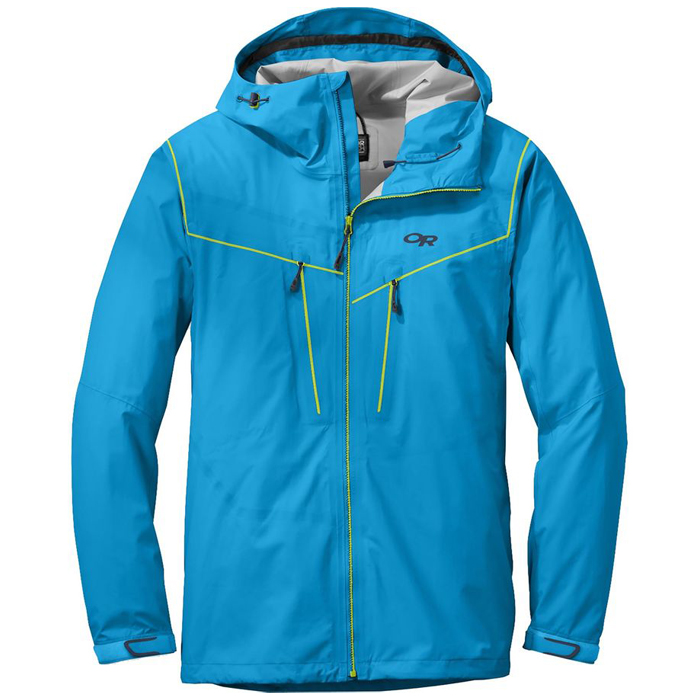
Active Junky testers took this Outdoor Research hardshell jacket through the ringers from coastal North Carolina to the high-altitude Colorado Rockies. Bringing above-average wind protection to breezes and major blows, the jacket stood up to precipitation ranging from sea spray to destructive downpours. At a lightweight 10.9oz, this shell jacket is packable but packed with weather-evading technology.
Pros: With dual pockets placed at the chest rather than the hips, you get easy pocket access when worn with waistbelts. This jacket’s ability to stretch and move made it a delight to wear, and testers found the 3L AscentShell fabric comparable in performance and breathability to Gore-Tex and eVent options. Underarm panels also boosted breathability, though this jacket doesn’t have pit zip like some other models. A sturdy storm flap backed up the reliable, single-pull zipper that remained easy to operate even with wet and gloved hands. The helmet-style, wire-brimmed hood was clearly designed with alpine insight.
Cons: The trim fit will make it difficult to layer, and without any insulation and a shorter back length, it may not be the best shell for extreme cold.
Best for: Three-season wear across the full spectrum of weather conditions and activities, travel and expeditions
Key Attribute: Weather Protection
Rab Firewall Jacket combines top technology from the brand for a reliable and durable outer shell jacket. Extreme conditions from frigid temperatures to torrential rain are this jacket’s forte, with more protection than necessary for moderate late spring, summer and early fall conditions. We recommend this Rab shell to anyone planning adventures in cold and adverse conditions, from alpine hiking to cold canyon exploration.
Pros: Pertex Shield delivers full, waterproof breathability in this hardshell jacket. With 3-layer fabric, this is a great choice for colder and alpine conditions. Dual, smooth-running pit zips feed the flow to cool down even during peak exertion with this 16oz. Rab jacket. Two pairs of high storage pockets provide ready access to electronics, maps and calories while staying well clear of even wider waistbelts. Zipper garages are right-sized to prevent binding or jamming in wet, snowy or muddy conditions. Rab’s beefy wire brim is a favorite to dial in hood fit while dual waist toggles seal the jacket simply and reliably.
Cons: A heavier weight and superior protection are over-kill in many locations and scenarios
Best for: Going harder in higher and colder environments
Key Attribute: Warmth

From revealing the 3-layer jacket’s origins to sweating the details, Patagonia continues to impress in this alpine-focused piece that testers wore well beyond couloirs into rain and sleet. The brand calls it “a study in balancing weight and protection,” and Active Junky deems it closer to quiver-of-one-jacket status. Testers reviewed the M10 hardshell jacket in trekking and mountain environments, and paddling and pedaling trials.
Pros: A contoured athletic fit ditches shoulder seams to avoid wear and promote full-rotational freedom of movement for the shoulders in this women’s hardshell jacket. Patagonia’s 3-layer H2No fabric is completely waterproof while remaining breathable, and exterior ripstop nylon handles abrasive environments. The full zip and hood pair to keep your face and neck protected while the hood also provides ample room to accommodate a helmet. This outer shell protects you from the elements, and with a regular fit, you can throw a midlayer on underneath for extra warmth.
Cons: The price maybe a deterrent here, but M10 is a worthy investment piece. Pocket placement is a bit low if you plan to wear a backpack with hipbelts.
Best for: Life-saving, experience-altering trips, including rock and ice climbing in most conditions
Key Attribute: Weather Protection
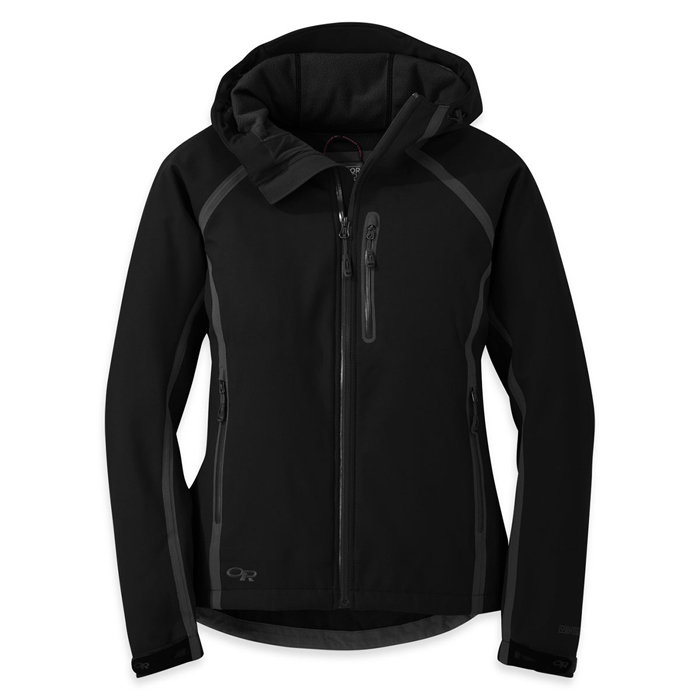
Testers loved Outdoor Research’s Mirthrill jacket, but couldn’t decide if the best part was the movement it provided or the solid weather protection. It looks technical, and performs just like it looks. This women’s softshell jacket shines hopping off a ski lift or hiking in the backcountry. It’s burly enough to face all kinds of weather and flexible enough to work with you through all kinds of physical activity. The weather protection it brings to the table is upper tier and the versatility of design makes it easy to utilize.
Pros: Robust and versatile, this jacket can withstand a lot of wind, rain, and snow before it starts to wet out thanks to 3-layer Ventia Soft-Shell fabric. And its sealed seams and zippers make this jacket truly waterproof despite being a softshell. The super soft fleece lining helps increase comfort while adding heat retention. The hood has a pliable bar in the brim to adjust to the perfect shape for maximum visibility when you're bundled up against a downpour or bombing down the slopes. The sleeves on this women’s softshell jacket are lusciously long and have the benefits of elastic, but also cinch down with a hook and loop tab.
Cons: As with all increased weather protection, there is a reduction in breathability and stretch.
Best for: Battling the elements; dynamic adventures where the terrain might vary and weather is pervasive
Key Attribute: Weather Protection
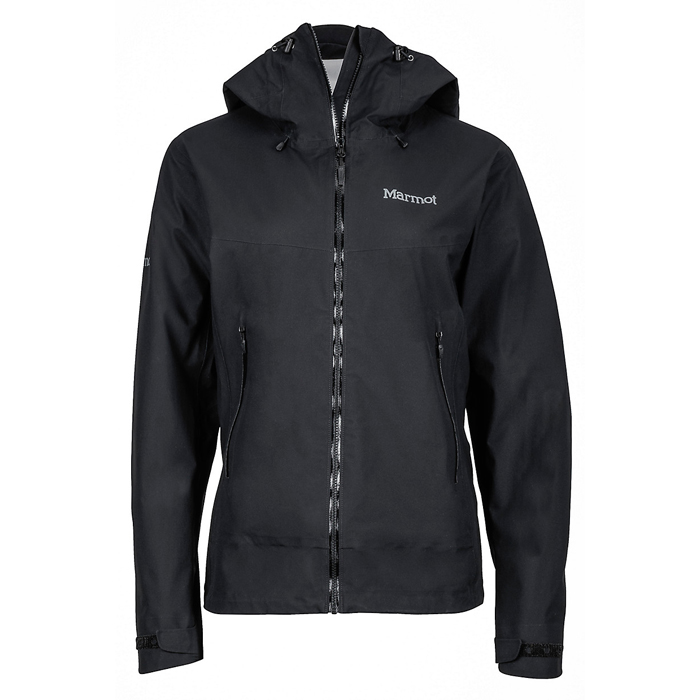
Three layers of Marmot’s NanoPro fabric equate to a waterproof and lightweight women’s shell that, with an athletic fit and Angel-Wing Movement, is ready for any outdoor activity with high performance across a wide range of activities. Put this one in the investment category as a worthwhile, multi-season upgrade or replacement for less rugged pieces.
Pros: NanoPro 3 Layer Fabric with 100% taped seams provide a crisp wall of protection. While not as quiet as other shell jackets we reviewed, the goal is more solid defense than fashionable wear. That said, the fit is trim with long pit zips that don’t kill the clean lines and guide-quality build. Higher pocket placement stays clear of pack straps, and the hood volume is well suited to hats and helmets; the moldable brim is less rigid and more forgiving that others tested. Hood adjustment toggles are fairly standard while the hardshell jacket’s panelized body moves well during more athletic pursuits.
Cons: Pricing pushes the top end in a 12.6oz piece, and its drawcord hem is average
Best for: Alpine adventures and activities where reliable movement is crucial
Key Attribute: Fit
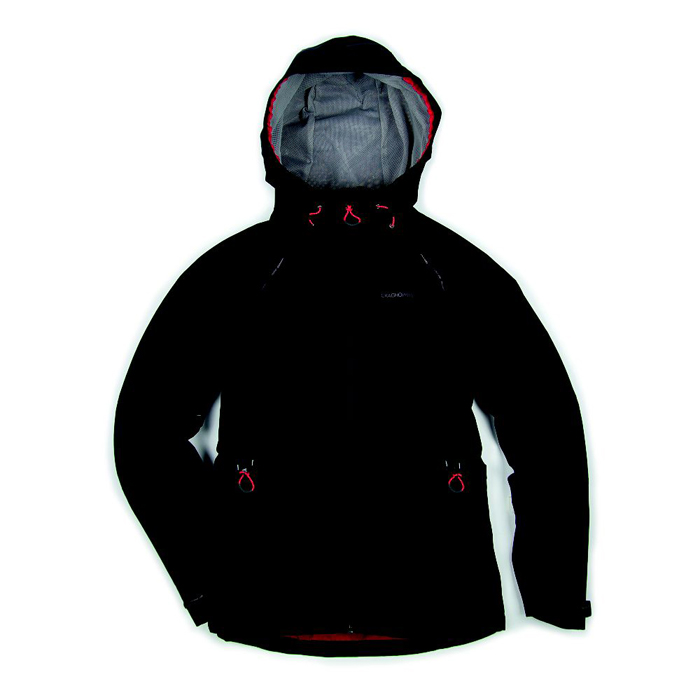
Partnering with National Geographic, Craghoppers designed the Olivia Pro Series jacket for outdoor adventures and international travel. Waterproof and breathable, the DWR AquaDry fabric protects in full downpours. And with an active fit and stretch material, this lightweight shell is ready for backcountry and urban exploration.
Pros: One of the best jackets tailored to average women with a relaxed fit that complements layers, the AquaDry membrane is a full-performance technology, one that comes with a three-year warranty. Being somewhat heavier than other hardshells under test, the Olivia Pro Jacket is less hard-core backcountry and more all-rounder. Lower back and butt coverage is superior, and reflective accents help in urban settings as dual, two-way pit zips add to Olivia’s adaptability to wider and more athletic uses.
Cons: The front pockets are pushed to the sides and located lower rather than higher on the shell’s body, which could be inconvenient if paired with a backpack. The hem elastic appears below the jacket when cinched, which could be a potential snag point.
Best for: Day hikes, snowshoeing and travel in moderate conditions at lower altitudes
Key Attribute: Protection

The North Face delivers a lot of heat for the size and weight of its Apex Elevation Jacket. With 100g of PrimaLoft insulation, it’s going to keep you cozy in most winter weather you’ll find yourself in. The Apex isn’t going to be a year-round staple, but could definitely be a winter essential with just enough warmth for colder temps and strong winds. It boasts some strong water resistance, a comfortable fit and good detailing.
Pros: The PrimaLoft insulation makes this a cold-climate-focused softshell jacket that brings a lot to the table. Adding to the cozy factor, the neck and cuffs are lined with a super-soft fleece, and the cuffs have an additional stretchy layer to seal in warmth. The cinch hood is detachable, giving you the versatility to remove some bulk when you’re just heading downtown, or zip on the hood when you need extra protection from the elements. And the hood’s zipper is protected by a small softshell flap so that your zipper isn’t your weak point in a downpour, or under a waterfall. Which is the cherry on top of this softshell jacket thanks to the DWR finish for water resistance and wind protection.
Cons: As we saw with other insulated jackets, once wet the Apex Elevation took a little longer to dry out. Also it is easily too much for even shoulder seasons.
Best for: Staying cozy in the winter months and chilly nights setting up camp and around the campfire.
Key Attribute: Warmth
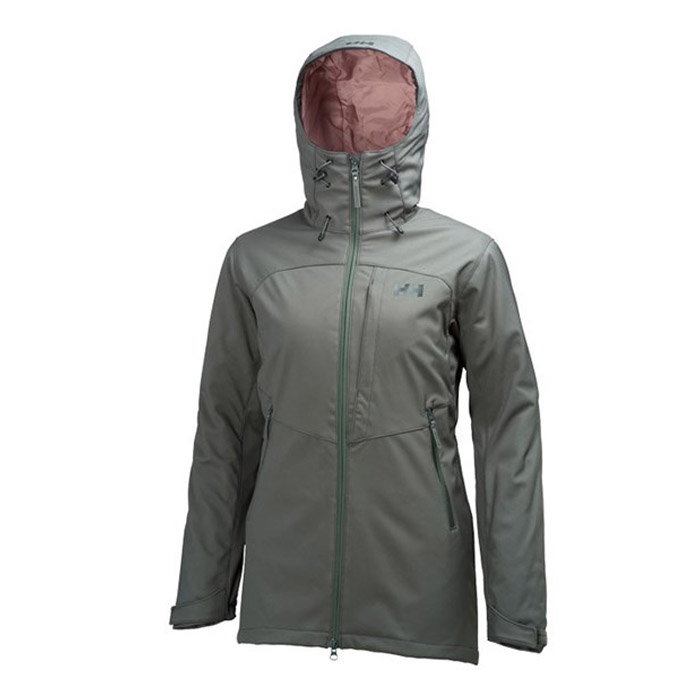
Stay warm and dry in this versatile insulated shell jacket. Helly Hansen puts out a few different items in its classically styled Paramount line that are made to eat up the wind and rain, but this one was winterized with the added benefit of PrimaLoft insulation to keep you warmer. The traditional and simple styling of this women’s softshell jacket allows it to fit in, but maybe not conquer, the fashion scene, while still providing a solid shield against winter weather.
Pros: DWR treatment gives this softshell jacket the benefits of being water resistant and windproof. The slightly stiff structure and adjustability of the hood make it incredibly comfortable. And when faced with gusty winds and sideways rain, this Helly Hansen jacket stayed in place and kept the moisture out. The winterization of the Paramount gives us a warm, PrimaLoft cocoon, plus it provides a longer cut in the torso, which helps keep you a little warmer and a little drier. The cuffs can be cinched tighter to seal up gloves or just keep out the elements, but were still comfortable and didn’t add any annoying bulk.
Cons: Due to the insulation it would take a little longer than uninsulated jackets to dry, and pocket placement is a little high for a relaxed stance, but they were still used heavily.
Best for: Staying warm and dry through the storm; battling sideways rain and biting wind
Key Attribute: Warmth
Stio’s solid fabric selection, consistent stitching and midlayer-compatible volume with the Modis Hooded Jacket will suit larger outdoor athletes in milder conditions. While some of the Modis’ attributes followed those of alpine pieces, it landed more in the mid-tier, performance-wise. We recommend buying it for easier pursuits rather than adrenaline-fueled adventures.
Pros: Stio advances a center-of-the-market, mid-tier shell with Modis. Testers loved the waterproof protection from Pertex Shield 2.5L fabric that guards against rain in all direction backed up by sealed seams. With 10,000mm waterproof and 5,000mm breathable ratings supported by dual pit zips, you can adjust and avoid overheating. Beefy Velcro cuffs resisted snags, and the jacket is held secure with workable, two-toggle waist adjustment to accommodate everything from tees to thicker layers under the jacket.
Cons: Testers found the hood a small hassle to adjust, taking plenty of manipulation to protect against wind and coastal rains with only a short brim to guard the face, and pockets were too low for easy access with a pack waistbelt.
Best for: Two- to three-season use in moderate climates, day hiking when extreme weather is not expected
Key Attribute: Durability
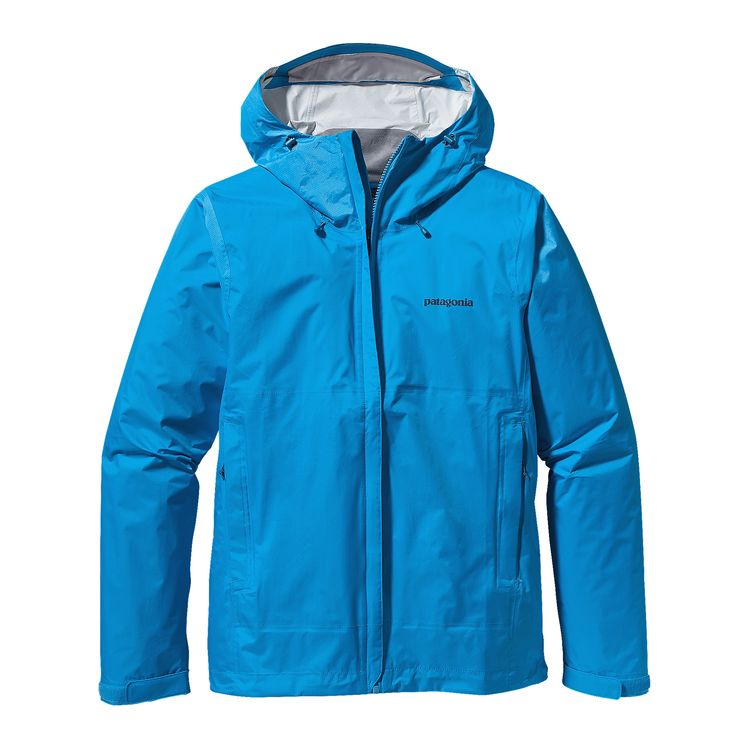
With an accommodating torso size and action-capable shoulder seams, the 2.5-layer Torrentshell is a bad-weather staple at an outstanding price. Testers found this hardshell a pleasure to travel with around the United States: unlike many others shell jackets we reviewed, Patagonia’s Torrentshell transitions from travel to trail and looks the part everywhere you and it go.
Pros: Dual hem toggles tighten the fit in wind and rain while two-way adjustments of the mid-volume hood are effective. Taken to extremes by testers in snowy shoulder-season conditions, Patagonia goes center-of-the-target for most hikers, travelers and occasional paddlers. Handwarmer pockets are generous enough for a hat, light gloves, energy bar and compass while the hood visor is the ideal size and stiffness to protect while still permitting full visibility. Breathability makes for comfortable all-day wear in cooler conditions, and if needed, pit zips effectively vent heat and moisture. The Torrentshell is a compact, high utility, comfortable men’s shell jacket.
Cons: With a shorter back length and dual pockets shifted lower on the front, backpacking is not this lightweight jacket’s strength.
Best for: Multi-sport, multi-season adventure travel that can push into moderate winter conditions
Key Attribute: Features

Arc’teryx has established itself in the outdoor industry for top-quality gear. The Atom LT Hoody lives up to that reputation, a midlayer comprised of material like Polartec Power Stretch, Hardface side panels, and Coreloft insulation to keep you at the ideal temperature by regulating body heat, not to mention being feathery and extremely comfortable. Lightweight and packable, wind and moisture resistant, this midlayer doubles as an outer-layer in many situations.
Pros: The Atom’s hybrid design performed exceptionally in the varying conditions. It combines Polartec Power Stretch with Coreloft insulation wrapped in Toray face fabric. The Coreloft insulation is baffled from the interior and not sewn through to the exterior, which gives the softshell jacket a smooth stitch-free exterior except along the seams. The sewn-in elastic cuffs and drawstring along the hem are excellent at keeping the elements out and the jacket in place. A key feature of the jacket is the Power Stretch sewn along the side of the torso and into the armpits that provides a ton of stretch and also allows for excess heat and moisture venting. Arc’teryx’s simple designs aren’t flashy, but they make up for it with performance and materials.
Cons: The vents on the side are not always effective when dumping heat, so overheating in milder conditions may be a concern.
Best for: Skiing, boarding, layering up on especially cold days when extra warmth keeps you going
Key Attribute: Warmth